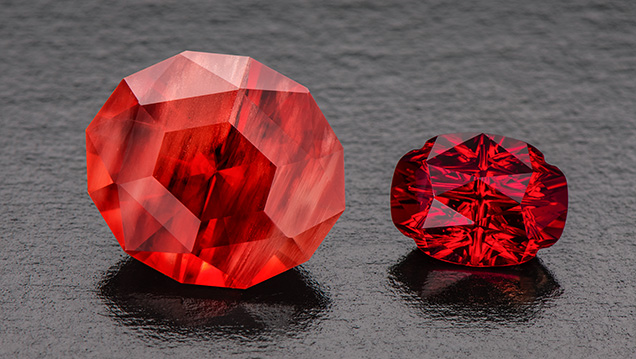Ponderosa Sunstone Update

John Woodmark, president of Desert Sun Mining and Gems (Depoe Bay, Oregon), updated us on the Ponderosa mine, which he calls the most productive source of Oregon sunstone (see above). Demand has increased annually over their 17 years of production, he said. With the larger excavator and high-capacity screen they brought on in 2015, they now mine about 4,300 kg (4.8 tons) of sunstone rough per year, up from about 2,000 kg (2.2 tons) in 2014. About 3% of this material is facet grade. Ponderosa now produces 4,000 to 5,000 cubic yards of concentrate in seven days—more than enough to process in one season (which only lasts five or six months due to snow at the high elevation). Desert Sun was once limited to mining at about 50 feet deep, but the excavator has allowed them to go a few hundred feet deep into the source. Woodmark said the sunstones at that depth are larger and less fractured, and there are some excellent red stones of good size.
Woodmark said demand is especially strong from American and European customers age 45 and under because they want natural, untreated gemstones such as sunstone, opal, and jade. They also love Oregon sunstone’s schiller effect, a sparkle caused by reflective copper platelets that makes the stone “different from what their friends have.” Desert Sun will be using social media this year for the first time to reach customers looking for unique gemstones.
Jewelers are excited about Oregon sunstone because of the potential high markup, according to Woodmark. He noted that sunstone isn’t competing with diamond, ruby, sapphire, and emerald, for which a jeweler might see a 10% or 15% profit margin. Oregon sunstone can yield a triple or quadruple markup, yet it is still relatively affordable: Woodmark said the yellow sunstones sell for about $30 per carat while the reds can go for $300 to $4,000 per carat. Sunstone’s affordability, profit margin, and appeal to young consumers make it attractive to jewelers.
Woodmark said the jewelry industry’s demand for calibrated sunstones continues to grow, and Desert Sun now receives significant orders from large companies. A typical order might be a thousand 5 mm rounds of orange sunstone. Every color sells well, he told us, but it is difficult to get a specific band of color in natural, untreated gemstones, so they are trying to grade more consistently. Desert Sun has seven colors, each graded with and without schiller, so overall there are 14. He tries to educate jewelers, manufacturers, and designers on the fact that color in natural stones is more variable—and that many have unique color—to encourage them to use more than one color in their pieces.
Woodmark sees a bright future for Oregon sunstone as more consumers become aware of it. He acknowledged that there will come a time when he and Bruce Moore, Desert Sun’s executive vice president, will have to step away from the deposit. “We’re barely scratching the surface of what people could do with this mine,” he said. Desert Sun only exhibits at the AGTA show in Tucson, but Woodmark said if someone were to take over the mine, they could do 10 shows a year across the United States. At that point, he said, sunstone would “take off.”
.jpg)


